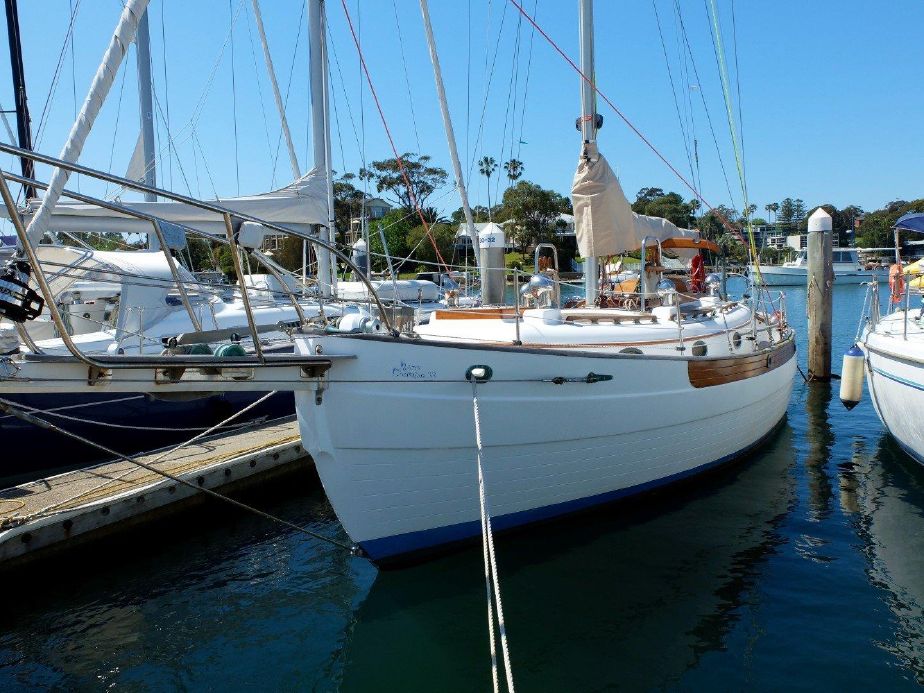There are some boats that people simply walk by at a boat show or their local marina and remark “Now that is a bluewater cruiser.” The Hans Christian 33 is one of these boats. So, is a bluewater cruiser simply a style that conjures up a feeling of adventure and far off cruising destinations, or are there actual features that define this class of vessel? The truth is, it’s a little bit of both.
A well-designed bluewater cruiser must have enough volume to accommodate fuel, water, food, clothing, and comfortable berths for one or more people for extended passages and extended stays in out-of-the way places. Solid construction, a safe cockpit, and secure deck areas are a must. In most cases, an offshore cruiser must be able to be easily handled by a small crew. And, last but not least, she must provide for comfortable and efficient sailing in a wide variety of conditions. When a designer combines all of these features into a boat with less than 33’ of length on deck, it’s no coincidence the result, like the Hans Christian 33, conjures up those feelings of adventure and sailing to far off, exotic destinations.
Design credit for the Hans Christian 33 goes to Harwood S. Ives. Although there is debate in some circles, I think it’s clear Mr. Ives, at least, had a hand in this design. The model was introduced in 1980 and built by Taiwanese craftsman in Taiwan in spite of some misleading advertising suggesting the Hans Christian 33 was “built by a master German craftsman … Herbert Ernst Guttler.” About 150 Hans Christian 33s have been built, most between 1980 and 1988, and although there is currently an effort to resurrect this model, I have not been able to confirm any newer models have actually been built.
The two words that best describe the construction of the Hans Christian are thick and heavy. For the most part, the hulls are a solid layup of chopped strand fiberglass mat and polyester resin. What’s lacking in sophisticated fiberglass technology is generally made up for in weight and thickness. Some degree of osmotic blistering below the waterline is common, but I have yet to see a condition that I believed to be structurally significant. Secondary bonding attachments of structural members are generally well done, although, due to installed joiner work, most are unable to be readily inspected. Decks are composite of plywood core, fiberglass inner and outer skins and teak overlays. Some teak overlays were not well bedded, and some moisture and delamination may be found in deck composites. But, again, initial construction is on the “overbuilt” side, and I have yet to find a condition that threatened the structural integrity of these boats. However, this is not to say these conditions will not worsen as these boats age if remedial measures are not taken.
Ballast is iron encased in the fiberglass keel cavity and is reportedly 6,800 pounds. The specified displacement is 18,500 pounds, although, on travel lift scales, most will weigh in at over 20,000 pounds.
Several deck arrangement features qualify the Hans Christian 33 as a true bluewater cruiser, at least one of which may not make her particularly well suited for coastal cruising and day sailing. For safety in all conditions, there are substantial bulwarks along the side and forward decks, very stout double life lines that are well above the average person’s knee height, and hand rails along the entire length of the cabin top. Although a desirable feature in an offshore sailing yacht, the very small cockpit will accommodate no more than two people comfortably for any length of time.
Below deck the most apparent feature is the extensive use of teak joiner work. There is teak virtually everywhere one looks, and for the most part, very well done.
A bluewater cruiser must have a good galley and berths that are well ventilated, large enough to be comfortable in a tropical environment, and able to be secured for offshore passages in heavy weather. I am particularly fond of the forward head arrangement followed by a port side Pullman berth and a starboard quarter berth cabin. This is the arrangement I have on my own boat, and although mine is not a bluewater cruiser, I have found the arrangement ideal. The galley is small but efficient, and there is more storage than you’ll find on most boats this size.
A variety of auxiliary diesel engines was offered ranging from 24 to 35 horsepower. Although 24 horsepower is on the minimal side for a boat that weighs nearly 20,000 pounds, there is a 3:1 reduction gear and a large propeller, so horsepower seems to be adequate. Engine access is fair but usually requires removing everything from an overloaded port cockpit locker.
The Hans Christian 33 is a cutter rig with a displacement/length ratio of well over 300 and a sail area/displacement of less than 16, so it’s clear this is a boat that will need a bit of a breeze to be at her best behavior.
Currently there are four Hans Christian 33s offered for sale in the U.S. at asking prices ranging from $95,000 to $120,000, and nine boats have been reported sold within the last year at an average selling price of $89,100.
The Hans Christian 33 is a stout, safe, and comfortable bluewater cruiser that is reasonably priced. But, be aware that these will be high maintenance boats to keep in Bristol fashion, and age will take its toll on teak decks. If your love of this style overwhelms your practical side, she will also make a very handsome coastal cruiser or day sailer.
Reviewed in the June 2007 issue of SpinSheet by Jack Hornor





